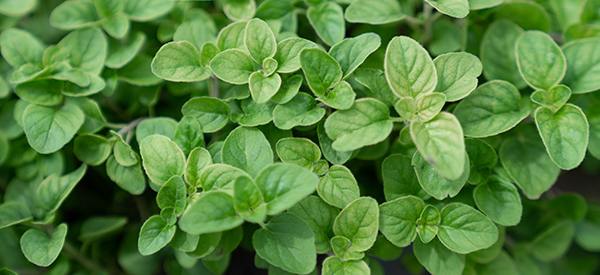
Oregano
Oregano, (Origanum vulgare), is often called Spanish Thyme, European Oregano, or Wild Marjoram. It is an important culinary and medicinal herb in the Lamiaceae or mint family of plants. It grows as a perennial herb, flowering profusely each summer similar to many other plants in the mint family. Closely related to marjoram (Origanum majorana), oregano adds a spicy flair to many Mediterranean dishes. Varieties of Origanum species are grown for their beauty as ornamental plants as well. Their flavor and medicinal compounds are sometimes muted in these hardy versions of Origanum vulgare.
The plant has been in use for so long its origin is obscure, but it is believed to have originated in Western Asia and its use dates back a few thousand years at least. Its name originates from ancient Greece and delightfully translates to “joy of the mountains”.
Oregano is the flavor that we associate with pizza and Greek salad. Truth be told, these dishes are just not the same without it.
More than just a tasty addition in many culinary endeavors, oregano has been used for its diverse medicinal properties for thousands of years as well. To this day, studies show oregano contains compounds with antifungal, antiviral, and antimicrobial activity. It also has potent antioxidant and anti-inflammatory activity with some evidence for weight loss, cholesterol control, antidiabetic action, and agents that suppress types of cancer.
The History of Oregano
As mentioned above, oregano has been used by humans for time immemorial. Ancient Egyptians used it, as did the ancient Greeks and Romans. The Greeks believed the wonderful herb was created by the Goddess Aphrodite, making the herb a symbol of joy.
The Romans helped perpetuate the use of this healthful, zesty herb as they found it easy to grow and enjoyed its flavors. With the help of the Romans, the use of Oregano spread throughout the ancient world of Europe and Northern Africa.
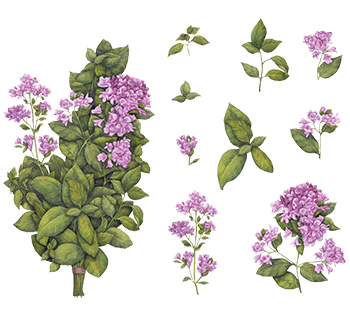
During the Middle Ages, along with the advent of many other documented plant-based medicines in Western Civilizations, oregano was used medicinally to help treat ailments such as toothache, indigestion, cough, colds, aches, and rheumatism.
From here, it began its spread throughout the temperate world, including farther into Asia and Africa. Oregano continues to be an important part of Traditional Chinese Medicine where it is used to aid the spleen, heart, bladder, kidney, and liver. In medicine folklore, oregano has been used to promote health, sleep, happiness, among its many other positive attributes.
Although oregano has naturalized throughout the world, it surprisingly wasn’t popular in the US until after the Second World War. The soldiers from the Italian Campaign brought it back with their long-lasting love of pizza.
Where the Plant is Found
In the wild, Origanum vulgare is often found at higher elevations in the Mediterranean climate. It is native to Europe’s Mediterranean regions as well as southern and central Asia. Currently, oregano is cultivated or has naturalized throughout the temperate regions around the world. The US, in addition to Italy, Greece, Spain, and Turkey are the main cultivated sources for Origanum vulgare. Many other cultivated species of Origanum are also produced for culinary, medicinal, and ornamental uses.
Related: The Complete Map of Edible Plants: Find Out What You Have in Your Area! (Video)
How to Identify Origanum Vulgare
- Shape: Oregano is a flowering perennial herb with a spreading, mounding shape. It reaches 1 ½ to 3 ½ feet tall.

- Leaves: Leaves are ½ to 2 inches long with small depressions at the veins. They emerge oppositely with each pair at right angles to the pair below. Leaves are ovate with pointed tips and dark green in color.
- Flower: The oregano’s flowers have five united petals and five united sepals and are bilaterally symmetrical. Flowers are purple to white and are produced in clusters at the terminal ends of erect spikes. Each flower is less than ¼ of an inch long.
- Stem: Stems are woody, tough, and purplish in color. They are right-angled and square.
- Fruit & Seeds: Seeds are prolific and are tiny, black, and round.
Related: 400 Wild Plants That You Can Forage For (Video)
How to Grow
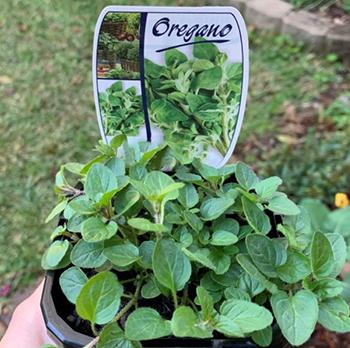 For the best flavor, oregano grows best in well-draining soil in full sun. Cooler seasons and heavy rich soils may result in flavor that has less intensity.
For the best flavor, oregano grows best in well-draining soil in full sun. Cooler seasons and heavy rich soils may result in flavor that has less intensity.
A great companion plant in the herb and vegetable garden. Oregano can be started from seed or by propagating cuttings from established plants.
Young plants can be pinched to produce bushier plants. Seedlings can be thinned out to space plants about 8 inches apart.
Plants may tend to lose flavor with age so rejuvenating or replacing oregano plants every three to four years is a great idea.
Related: The 10 Medicinal Seeds You Should Plant for a Complete Backyard Pharmacy (Video)
How to Harvest Origanum vulgare
The best time of day to harvest oregano leaves is during the warmest part of the day when all the dew has dried. Leaves can be harvested anytime during the growing season.
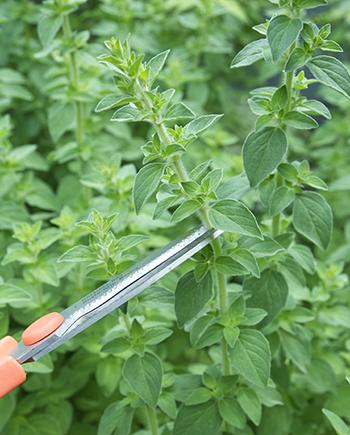
There are two main times when the harvested leaves are at their best. The first time is when the plant is young. This harvest performs two tasks. Pinching back stems to generate bushier growth and using the harvested leaves. When the stems are about 8 to 12 inches tall, trim the top 4 to 6 inches. Use shears or scissors and cut just above a set of leaves.
The second time to harvest is just as the blossoms begin to open. Leaves tend to be smaller but more intensely flavored at this time. During the heat of the day, the burgeoning blossoms will be attractive to pollinators. Try not to disturb any busy bees or other stinging beneficial insects while harvesting.
What Oregano Is Good For & The Natural Remedies Made From It
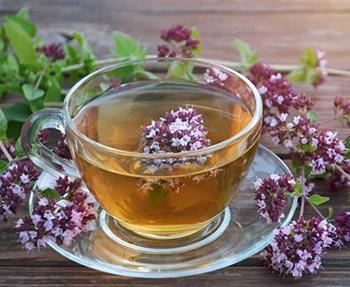 Oregano makes a warming, soothing tea that aids several health concerns. These include respiratory ailments such as congestion, cough, and sore throat. There is also evidence that oregano tea has many benefits for digestive issues and may even be helpful in reducing intestinal infections, irritable bowel syndrome, and colitis.
Oregano makes a warming, soothing tea that aids several health concerns. These include respiratory ailments such as congestion, cough, and sore throat. There is also evidence that oregano tea has many benefits for digestive issues and may even be helpful in reducing intestinal infections, irritable bowel syndrome, and colitis.
Topically, oregano can be used to treat skin afflictions. Itchy skin, infections, sores, and aching muscles may be alleviated with the use of compresses or infusions that include oregano.
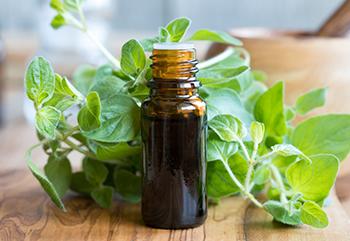
Oregano essential oil is a familiar natural remedy for many bothersome health issues. Often, oregano essential oil is available as Oil of Oregano. This is usually oregano essential oil blended in a carrier oil at a ratio of 1:1, 1:2, or 1:4. Oil of Oregano and Oregano essential oils are high in antioxidants as well as antimicrobial activity. This makes these products indispensable for fighting infection, wound care, oral health care, fighting cold and flu, among many other potential healthful benefits.
What Parts of Oregano Are Used In Remedies?
The leaves and stems of Origanum vulgare are the parts of the plants which contain the main helpful compounds. Compounds found in oregano are called terpenes, terpenoids, and phenols. They have powerful antifungal, antiviral, and antimicrobial activity, as well as a potent antioxidant and anti-inflammatory activity with some evidence for weight loss, cholesterol control, antidiabetic action, and agents that suppress types of cancer.
Three of the main compounds that give oregano these wonderful medicinal qualities are carvacrol, thymol, and rosmarinic acid.
- Carvacrol is an antibacterial powerhouse, may aid weight loss, reduce inflammation, lower cholesterol, and may help to fight certain types of cancer.
- Thymol supports the immune system while protecting against toxins and working as a natural antifungal agent including different types of candida. In fact, oregano essential oil has been shown to be more effective than any other essential oil tested in fighting candida infections.
- Rosmarinic acid is a potent antioxidant. Oregano oil shows much more antioxidant levels than even blueberries. This is due to the high levels of the rosmarinic acid compound found in oregano oil.
A DIY Recipe for Oregano Infused Oil
Ingredients
- Clean, sterile glass jar.
- Dried or fresh Origanum vulgare leaves.
- High-quality oil such as extra virgin olive oil.
Method
Step 1: Gather fresh and/or dried oregano. Here I have dried oregano from an earlier harvest. Some new shoots from a young plant which are fresh. There are also stems that are fresh and just about to bloom.

Step 2: Crumble dried leaves into a clean, sterile glass jar. I am layering with a few fresh leaves just to add an extra zing.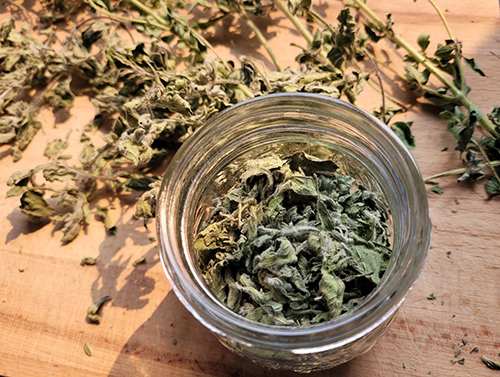
Step 3: Once the jar is almost full, stir up the leaves so that they settle and mix well.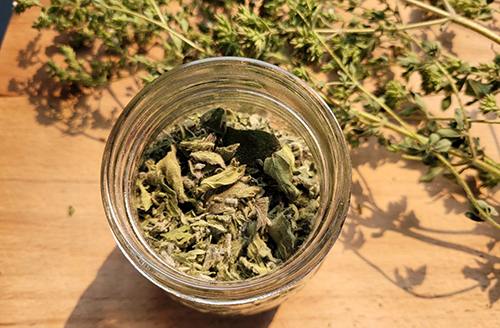
Step 4: Slowly pour high-quality oil over the crumbles leaves.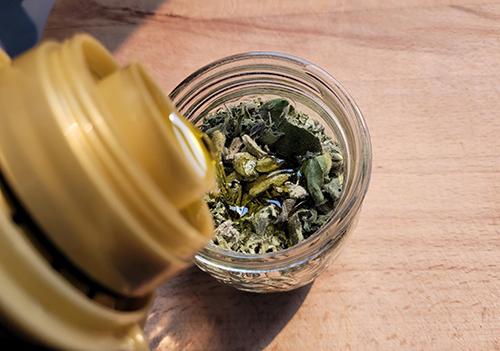
Step 5: Give the leaves a stir in the oil to release any air pockets and to ensure the leaves are fully coated.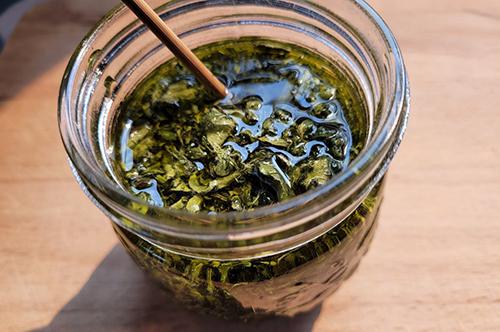
Step 6: Put the oil infusion in a cool dark place for 2 to 4 weeks to allow the wonderful flavor and medicinal compounds to infuse into the oil. Once the oil infusion is at your desired doneness, filter out the leaves using a wire mesh or filter cloth. Wire mesh is often enough and won’t soak up extra oil. Put the infused oil in an herb bottle or dropper. Protect the bottle from light and heat. The infusion will last 6 months to a year.
Potential Uses of Oregano Infused Oil
- Oregano-infused oil can be used as any herb-infused oil. It can be used to flavor foods, added to salad dressing, marinades, or drizzled over stews, soups, vegetables, or grains for an added healthful flavor boost.
- In addition, oregano-infused oil can be a cost-effective and homemade replacement for products such as oregano essential oil and oil of oregano.
- Oregano-infused oil can be taken internally to aid respiratory illnesses, indigestion, and gastrointestinal illnesses.
- It can be used topically on its own or as an ingredient in salve-making. Oregano-infused oil may be used to treat fungal and bacterial infections and promote wound healing. It may also be beneficial for skin problems such as acne, psoriasis, rosacea, and athlete’s foot.
- An effective home remedy for sore muscles aches, oregano-infused oil can be rubbed on sore areas of the body. Additionally, it may replace products such as VapoRub and be used as a chest rub to relieve congestion.
- Oregano-infused oil can be added to boiling water and inhaled to help relieve chest congestion, sinus infections, asthma, or other respiratory illnesses.
Related: A Step-by-Step Approach to Deal With Almost Every Skin Injury and Condition (Video)
Dosage
Currently, there is no recommended dosage for the use of oregano and its related products. If using pure oregano essential oil, it is powerful stuff. It should be diluted into a carrier oil before using it topically.
How To Preserve Origanum Vulgare
Oregano can be preserved in several ways.
In Oil: As above, the fresh or dried oregano is preserved in oil which will last from 6 months to a year.
Related: How to Make Herbal Ice Cubes
Freezing: Some herbs are amenable to freezing. They maintain their flavor better with this method compared to drying. I find this is true for dill and parsley. I am not convinced that frozen oregano performs better, at least in culinary usage than its dried counterpart. I do love a few frozen oregano stems to grab out of the freezer during the winter to use as herbal steam when fighting chest congestion. For this, I simply pack a freezer-friendly glass container with young oregano stems. These are great for herbal steams. They also are wonderful to throw into a soup pot, or alongside a roasting chicken.
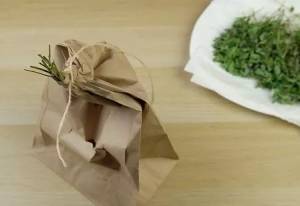
Drying: Drying is the method of choice for Origanum vulgare. This is because the dried leaves maintain the most flavor, in my opinion. This is echoed throughout my research from many other oregano fanatics as well.
My favorite way to dry oregano is to simply collect a bunch of stems. De-leafing oregano is a fiddly proposition. So, I don’t do this. I simply place all the bunches in a paper bag or a fabric rice bag and hang it in the garden shed.
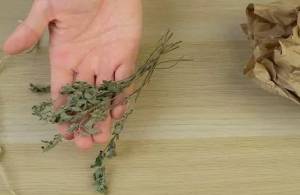
Any place that is dark and dry with excellent air circulation will do. The root cellar does not work for me as the humidity is too high and the leaves don’t dry nicely.
In the past, I would dry herbs like oregano in a cooled oven overnight. This did the trick but doesn’t retain the lovely green color of the leaves.
Once the leaves are dry, after several weeks, the leaves easily crumble off the stems. Crumble the leaves into an airtight container and use them within one year.
What Plants Resemble Oregano?
| Plant | Oregano, Origanum vulgare | Catmint, Nepeta | Marjoram, Origanum majorana |
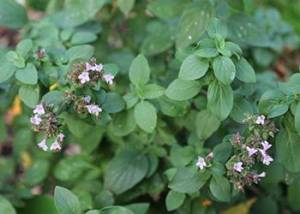 |
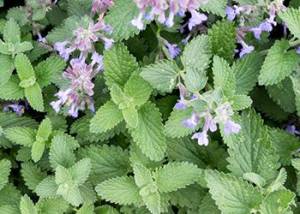 |
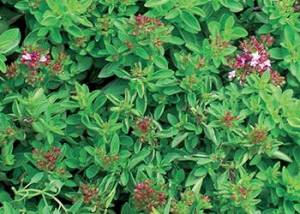 | |
| Size | 1 to 3 feet | 1 to 3 feet | 1 to 2 feet |
| Leaves and Stems | Smooth dark green leaves on purplish square stems | Serrated green leaves on gray-green square stems | Smooth, simple, oval green leaves on brownish square stems |
| Flowers | White, pink, purple round clusters at tip of stems. | Lilac, blue, white, and pink long clusters at the tip of stems. | Pink to purple round clusters at tip of stems. |
Warnings and Cautions
In normal amounts of oregano used to flavor foods, it is considered safe. The use of oregano essential oils is also considered safe. They should be diluted in a carrier oil when used topically. Some oregano essential oils are made specifically for taking internally. This should still be used with caution and following the direction of healthcare professionals.
There are possible side effects such as allergies. Precautions should be taken by susceptible people.
For women who are pregnant or breastfeeding, the medicinal use of oregano and its products are also not recommended.
Oregano is considered safe for topical use. Of course, with any new ingredient do a small skin test by placing a small amount of the oil or resin on the skin and wait 24 hours. Any reaction such as itchiness or hives may be an indication of sensitivity. It only makes sense to practice some caution with topical use for people who suffer from seasonal allergies.
Always check with your healthcare provider before starting new herbal remedies.
You may also like:
 How to Treat Fungal Infections with Oregano
How to Treat Fungal Infections with Oregano
1 Cup Before Bed Shrinks Belly Fat All Night (Video)
16 Medicinal Herbs You Should Grow Side by Side






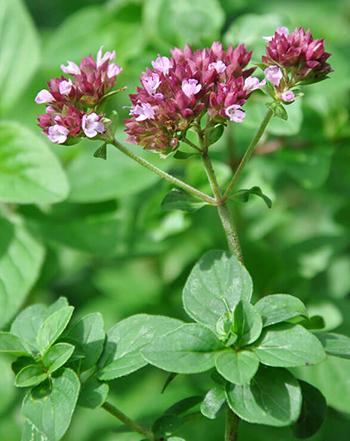
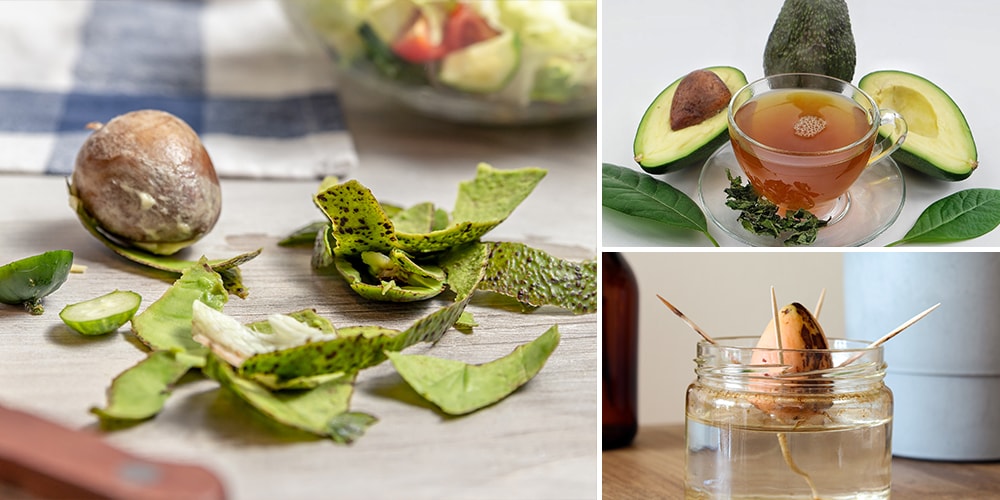
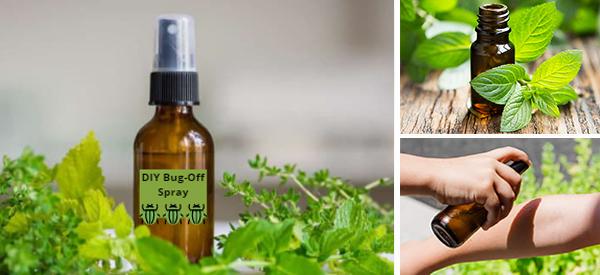
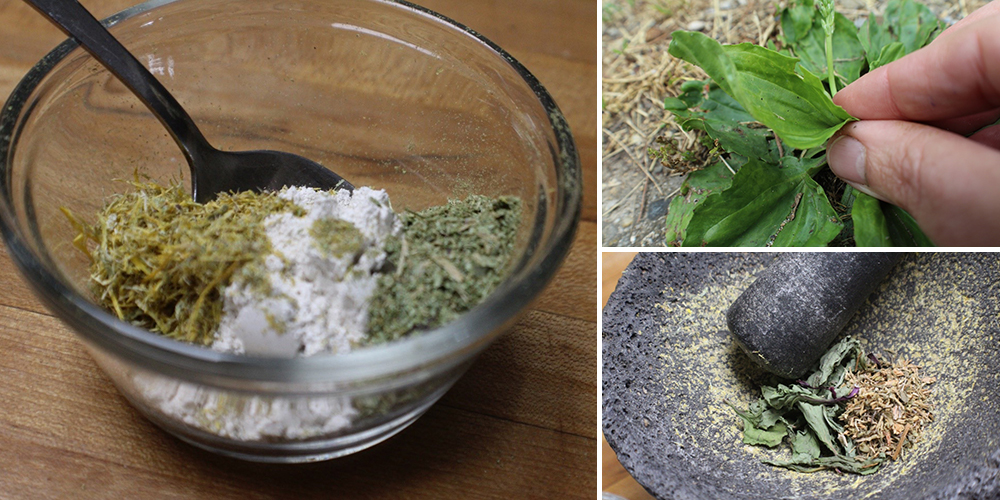
My elder parents have terrible foot fungus! Will oregano help this type of fungus?
Hi Billie,
There are numerous ways to apply oregano medicinally. Oregano-infused herbal oil, tincture, and tea can all be either applied externally or internally for fungal infections; whereas oregano essential oil is strictly for external use only, must be diluted, and should only be applied for a 2-week period. In the article below you can find 10 different ways to treat fungal infections with oregano:
https://thelostherbs.com/how-to-treat-fungal-infections-with-oregano/
Many blessings and good health!
I had a fungus on my one toe for years. I applied oregano oil once in a while and it was looking better each time I did it. Then I finally cured it completely. At night I put fresh aloe vera flesh in a plastic bag and wore it on my foot with a sock on top. During the day I applied oregano oil (Oreganol). I did it a few days in a row and the fungus is gone for 4 or 5 years. It has to be done more than once. I think at least 2 days in a row and then every other night for a few nights.
I don’t appreciate the Click Bait “one cup before bed shrinks belly fat all night” that has no connection to The Lost Herbs and nothing to do with oregano. Stop promoting B.S. products
Hi Barbara,
Thank you for your comment.
Your feedback is highly appreciated and will help us to improve our ability to serve you and other users of our websites.
Many blessings and good health!
Oregano is an invasive plant.
Unless you want ti everywhere, best to grow it in a 5 gallon bucket with drain holes NEAR (not on) the bottom.
If holes are on the bottom, then bucket should be placed on a concrete patio slab or driveway.
Hi Crazysquirrel,
Thank you for your comment.
Because oregano is a member of the mint family, it spreads and can become invasive. Indeed, planting oregano in buckets or containers is, a great option to prevent this.
Many blessings and good health!
I’ve yet to have the plants survive more than a few weeks in containers. They grow good for a short while then taper off and get root rot. I’ve tried several watering regimes, but none seem to fit the plant.
Hi Mark, I put mine in it’s own raised bed about 4×4 and just let it go. I only water when we haven’t had rain for a week or so. Mine comes back every year here in the NorthEast. Good luck!
Thank you for so generously sharing your knowledge with us. I appreciate the detailed care you take to explain the purpose, history, and process.
Hi Soraya,
Thank you so much for your support.
Many blessings and good health!
So many valuable pieces of information! I used an Oregano Tincture from the book back when I had the ‘rona and it kept me going! Thanks for sharing!
I was wondering if coconut oil would be a useful substitute for olive oil since the latter is difficult at best to get. there are just too many bootlegged versions mixed with other cheap oils.
Since coconut oil tends to saturate in colder temperatures (and directions say to store in a cool, dark place) I’d use MCT oil. It’s a form of coconut oil that does not saturate, even when cold.